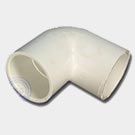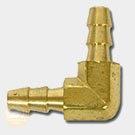Fittings fit, it's true. But how? There are a number of connection types and standards, and many of them don't make much sense; shouldn't something that measures 1/2 inch be referred to - in physical reality - as being 1/2 inch? Alas, plumbing is its own game with its own rules, which extend to measurements and dimensions. Seemingly arbitrary units are the norm; what does "nominal" refer to, anyway?
Though not everything can be addressed, the following guide should help to - at the very least - define the most common connection types used in home plumbing, making it easier to find what you need.
Threaded

Brass IPS Elbow
Brass, galvanized, stainless steel and other non-copper fittings are often threaded, and the standard used is often the National Pipe Thread (NPT) standard. This is interchangeable with IPS - Iron Pipe Size - which you'll see a lot of on our site. PVC fittings, when threaded, also use this thread type. When pipe is measured using IPS dimensions, the corresponding fitting size matches the IPS measurement: a 3/4" pipe will take a 3/4" IPS fitting. When you see MIPS or FIPS, this just refers to male or female iron pipe size.
Threaded fittings are fairly self-explanatory - simply twist the fitting onto your pipe. However, you'll need to take care not to unscrew the other end of the pipe as you're tightening the fitting on this end.
Compression

Brass Compression Elbow
Compression fittings are one of the quickest and easiest ways to join two lines. These connections are typically used on hard copper pipe and soft tubing that has a 3/8" or smaller outside diameter (like faucets and icemakers). Compression fittings are sized according to that outside diameter: a 1/2" OD pipe would require a 1/2" compression fitting. A sleeve ("ferrule") is placed over the pipe (use a plastic sleeve for plastic tubing), which is placed inside the fitting. A nut is placed over that, which when tightened, creates a seal. These fittings must not be overtightened - once resistance is encountered, go no more than a half-turn further.
Though regularly used instead of soldering, compression connections should only be installed in stationary situations with little movement or impact on the plumbing. If such activity is expected, soldering is recommended. Compression fittings are intended for one-time use only, and are not to be used in gas applications.
Flare

Brass Flare Elbow
Flare connections are used when water pressure is high, or for gas distribution: applications with higher pressures than a compression fitting could handle. When used with soft copper, a special tool (called a flaring tool) is used to flare the tubing, modifying its shape to facilitate a tight seal with the cone-shaped flare piece. Flare fittings are sized to match the OD of the pipe being connected: if the pipe measures 1/2" OD, a 1/2" flare fitting is what you need.
C / SWT (Sweat) / Socket

Copper Sweat Elbow
This type of unthreaded fitting is meant to be soldered (or "sweated") onto copper pipe. "Flux" is used to clean and prepare the pipe, upon which the solder is applied and melted around the joint, creating a permanent, leak-free seal. This is among the oldest and most trustworthy methods of connecting pipes. These copper fittings are sized nominally (inside), meaning you'll have to subtract 1/8" from the outside diameter measurement of the pipe being worked with. Some fittings also have an "FTG" end - this sizing matches that of the pipe, meaning that end can be connected directly into another fitting (just as a pipe would), but not over that size pipe. For non-plumbing applications, like refrigeration, outside diameter may be used to describe both the pipe/tubing and the fittings.
Slip / Hub

PVC Slip Elbow
Similar to the above copper sweat connection, slip fittings are unthreaded, and require the use of another material to seal the connection. Slip fittings are used with plastic piping - ABS, CPVC, and PVC. They are joined together using a primer that cleans and pre-softens the plastic, and a glue that binds pipe and fitting together, making one piece out of two. Due to its chemical composition, ABS does not require the primer step.
PVC and ABS slip connections follow IPS sizing, while most CPVC uses Copper Tube Sizing (CTS), meaning the types are not interchangeable.
Push-to-Fit (SharkBite, ProBite, John Guest)

SharkBite Push-Fit Elbow
These fittings are aimed at ease and simplicity, requiring the user to simply push the pipe or tubing into the fitting to secure a watertight connection. Used with copper pipe (not tubing), CPVC, and PEX (a special insert is available to maintain the integrity of PEX when using these fittings), the connection is made possible by a combination of specially-designed o-rings and metal teeth that grip and hold the pipe or tube in place. These are not permanent connections, but do require the use of a special tool to disconnect in the case of ProBite and Sharkbite. While every connection benefits from having a clean, deburred end (no rough edges or random little bits hanging on), it's particularly important with these fittings: relying only upon an o-ring and some teeth for a connection means that any sharp edges or debris can hold a more destructive threat than normal.
Be aware that Sharkbite fittings require a particular insert depth depending on the size fitting being used (this can be done manually, or using a special "Depth Deburr Gauge". Push-to-fit fittings typically use CTS sizing.
Barb

Brass Barb Elbow
Barbed fittings are used to connect flexible tubing (including garden hoses) to metal or plastic piping. The barbed end of the fitting is pushed into the hose, and a clamp tightened around it to secure a seal. Barbs are sized by the ID of the hose to be connected. The other end typically utilizes an IPS (MIPS or FIPS), GHT or slip connection. These types of fittings are commonly used in commercial beverage applications, such as tap lines or soda fountains.
Garden Hose Thread

Brass Hose Adapter
Garden Hose Threads (GHT: Male=MHT; Female=FHT) are coarser than standard pipe threads; even coarser are fire hose threads (NST), which quickly connect for obvious reasons. These fittings are usually used to adapt a garden hose to another connection, be it a hose bibb, a quick-connect fitting, or a nozzle, and use a washer to guarantee a tight seal.
... And there's your crash course in the most common fitting connection types! Many of our product pages have further information on these connections, specific to the product being used. Nobody likes returns (and even worse is being wrong), so if you aren't sure about what you need, you can always drop us a line!
